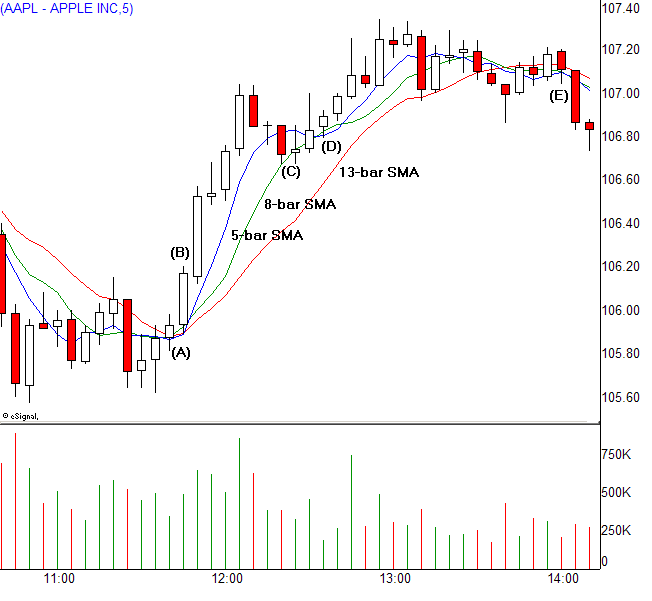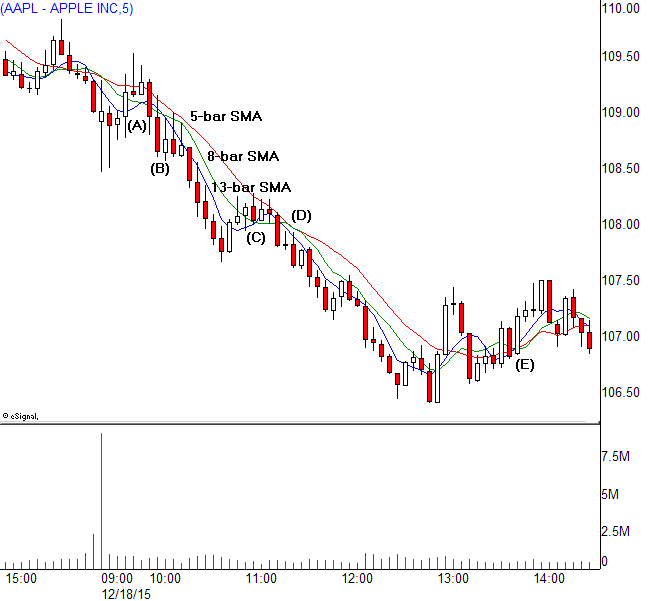Day traders need continuous feedback on short-term price action to make lightning fast buy and sell decisions. Intraday bars wrapped in multiple moving averages serve this purpose, allowing quick analysis that highlights current risks as well as the most advantageous entries and exits. These averages work as macro filters as well, telling the observant trader the best times to stand aside and wait for more favorable conditions.
Choosing the right moving averages adds reliability to all technically-based day trading strategies, while poor or misaligned settings undermine otherwise profitable approaches. In most cases, identical settings will work in all short-term time frames, allowing the trader to make needed adjustments through the chart’s length alone.
Given this uniformity, an identical set of moving averages will work for scalping techniques as well as for buying in the morning and selling in the afternoon. The trader reacts to different holding periods using the charting length alone, with scalpers focusing on 1-minute charts, while traditional day traders examine 5-minute and 15-minute charts. This process even extends into overnight holds, allowing swing traders to use those averages on a 60-minute chart.
5-8-13 Moving Averages
The combination of 5, 8 and 13-bar simple moving averages (SMAs) offers a perfect fit for day trading strategies. These are Fibonacci-tuned settings that stand the test of time, but interpretive skills are required to use the settings appropriately. It’s a visual process, examining relative relationships between moving averages and price, as well as MA slopes that reflect subtle shifts in short-term momentum.
Increases in observed momentum offer buying opportunities for day traders, while decreases signal timely exits. Decreases that trigger bearish moving average rollovers in multiple time frames offer sell short opportunities, with profitable sales covered when moving averages start to turn higher. The process also identifies sideways markets, telling the day trader to stand aside when intraday trending is weak and opportunities are limited.
Two Trading Examples
1) Using 5-8-13 in a Long Trade

Fig 1
Apple (AAPL) builds a basing pattern above 105 (A) on the 5-minute chart and breaks out in a short-term rally over the lunch hour (B) The 5, 8 and 13-bar SMAs point to higher ground while the distance between moving averages increases, signalling rising rally momentum. Price moves into bullish alignment on top of the moving averages, ahead of a 1.40 point swing that offers good day trading profits.
The rally stalls after 12 pm, dropping price back to the 8-bar SMA (C), while the 5-bar SMA pulls back and finds support at the same level (D), ahead of a final rally thrust. Aggressive day traders can take profits when price cuts through the 5-bar SMA or wait moving averages to flatten out and roll over (E), which they did in the mid-afternoon session. Both price levels offer beneficial exits.
2) Using 5-8-13 in a Short Sale

Fig 2
AAPL consolidates near 109 at the end of a session (A) and ticks lower the next morning (B) The 5, 8 and 13-bar SMAs point to lower ground while the distance between moving averages increases, signalling rising selloff momentum. Price moves into bearish alignment on the bottom of the moving averages, ahead of a 3-point swing that offers good short sale profits.
The selloff stalls mid-morning, lifting price into the 13-bar SMA (C) while the 5-bar SMA bounces until it meets resistance at the same level (D), ahead of a final selloff thrust. Aggressive day traders can take short sale profits while price lifts above the 5-bar SMA or wait for moving averages to flatten out and turn higher (E), which they did in the mid-afternoon. Both price levels offer beneficial short sale exits.
Signals to Stand Aside
Interrelationships between price and moving averages also signal periods of adverse opportunity-cost when speculative capital should be preserved. Trendless markets and periods of high volatility will force 5, 8 and 13-bar SMAs into large scale whipsaws, with horizontal orientation and frequent crossovers telling observant traders to sit on their hands.
Trading ranges expand in volatile markets and contract in trendless markets. In both cases, moving averages will show similar characteristics that advise caution with day trading positions. These defensive attributes should be committed to memory and utilized as an overriding filter for short-term strategies because they have an outsized impact on the profit and loss statement.
Avoiding Whipsaws

Fig 3
AAPL bobs and weaves through an afternoon session in a choppy and volatile pattern, with price whipping back and forth in a 1-point range. 5, 8 and 13-bar SMAs shows similar whipsaws, with multiple crossovers but little alignment between moving averages. These high noise levels warn the observant day trader to pull up stakes and move on to another security.
In Summary
5, 8 and 13-bar simple moving averages offer perfect inputs for day traders seeking quick profits on the long and short sides. The moving averages also work well as filters, telling fast-fingered market players when risk is too high for intraday entries.
Alan Farley can be contacted on this link: Hard Right Edge
Choosing the right moving averages adds reliability to all technically-based day trading strategies, while poor or misaligned settings undermine otherwise profitable approaches. In most cases, identical settings will work in all short-term time frames, allowing the trader to make needed adjustments through the chart’s length alone.
Given this uniformity, an identical set of moving averages will work for scalping techniques as well as for buying in the morning and selling in the afternoon. The trader reacts to different holding periods using the charting length alone, with scalpers focusing on 1-minute charts, while traditional day traders examine 5-minute and 15-minute charts. This process even extends into overnight holds, allowing swing traders to use those averages on a 60-minute chart.
5-8-13 Moving Averages
The combination of 5, 8 and 13-bar simple moving averages (SMAs) offers a perfect fit for day trading strategies. These are Fibonacci-tuned settings that stand the test of time, but interpretive skills are required to use the settings appropriately. It’s a visual process, examining relative relationships between moving averages and price, as well as MA slopes that reflect subtle shifts in short-term momentum.
Increases in observed momentum offer buying opportunities for day traders, while decreases signal timely exits. Decreases that trigger bearish moving average rollovers in multiple time frames offer sell short opportunities, with profitable sales covered when moving averages start to turn higher. The process also identifies sideways markets, telling the day trader to stand aside when intraday trending is weak and opportunities are limited.
Two Trading Examples
1) Using 5-8-13 in a Long Trade

Fig 1
Apple (AAPL) builds a basing pattern above 105 (A) on the 5-minute chart and breaks out in a short-term rally over the lunch hour (B) The 5, 8 and 13-bar SMAs point to higher ground while the distance between moving averages increases, signalling rising rally momentum. Price moves into bullish alignment on top of the moving averages, ahead of a 1.40 point swing that offers good day trading profits.
The rally stalls after 12 pm, dropping price back to the 8-bar SMA (C), while the 5-bar SMA pulls back and finds support at the same level (D), ahead of a final rally thrust. Aggressive day traders can take profits when price cuts through the 5-bar SMA or wait moving averages to flatten out and roll over (E), which they did in the mid-afternoon session. Both price levels offer beneficial exits.
2) Using 5-8-13 in a Short Sale

Fig 2
AAPL consolidates near 109 at the end of a session (A) and ticks lower the next morning (B) The 5, 8 and 13-bar SMAs point to lower ground while the distance between moving averages increases, signalling rising selloff momentum. Price moves into bearish alignment on the bottom of the moving averages, ahead of a 3-point swing that offers good short sale profits.
The selloff stalls mid-morning, lifting price into the 13-bar SMA (C) while the 5-bar SMA bounces until it meets resistance at the same level (D), ahead of a final selloff thrust. Aggressive day traders can take short sale profits while price lifts above the 5-bar SMA or wait for moving averages to flatten out and turn higher (E), which they did in the mid-afternoon. Both price levels offer beneficial short sale exits.
Signals to Stand Aside
Interrelationships between price and moving averages also signal periods of adverse opportunity-cost when speculative capital should be preserved. Trendless markets and periods of high volatility will force 5, 8 and 13-bar SMAs into large scale whipsaws, with horizontal orientation and frequent crossovers telling observant traders to sit on their hands.
Trading ranges expand in volatile markets and contract in trendless markets. In both cases, moving averages will show similar characteristics that advise caution with day trading positions. These defensive attributes should be committed to memory and utilized as an overriding filter for short-term strategies because they have an outsized impact on the profit and loss statement.
Avoiding Whipsaws

Fig 3
AAPL bobs and weaves through an afternoon session in a choppy and volatile pattern, with price whipping back and forth in a 1-point range. 5, 8 and 13-bar SMAs shows similar whipsaws, with multiple crossovers but little alignment between moving averages. These high noise levels warn the observant day trader to pull up stakes and move on to another security.
In Summary
5, 8 and 13-bar simple moving averages offer perfect inputs for day traders seeking quick profits on the long and short sides. The moving averages also work well as filters, telling fast-fingered market players when risk is too high for intraday entries.
Alan Farley can be contacted on this link: Hard Right Edge
Last edited by a moderator:
